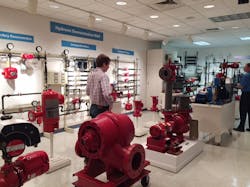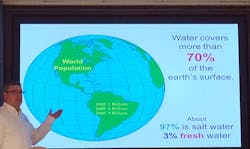CHICAGO — Just recently, Candace Roulo, senior staff writer for CONTRACTOR, attended a Plumbing Systems Design Seminar at the Bell & Gossett, a Xylem brand, Little Red Schoolhouse, located in Morton Grove, Ill.
The Little Red Schoolhouse offers many seminars — from a service and maintenance of water based HVAC systems seminar to a modern hydronic heating systems seminar — for industry professionals, including plumbing, hydronic and HVACR contractors and engineers.
The three-day Plumbing Systems Design Seminar covered the properties of water; centrifugal pumps used in plumbing systems; important information gained from pump curves; and an overview of pressure booster systems, domestic hot water heating and recirculation systems, wastewater systems and rainwater harvesting systems. Other topics discussed were water purity, Legionella, scalding and lead in potable water systems.
At the beginning of the seminar, Larry Konopacz, manager of training and education at the Little Red Schoolhouse reviewed some interesting stats regarding water:
- People living in residential areas in North America and Japan use about 92 gallons of water per day compared to people living in Europe — they use 52 gallons per day.
- In sub-Sahara Africa people use only 2.6 to 5.2 gallons of water per day.
- Experts have estimated that water consumption rates are rising at twice the rate of population growth.
- About 2.5% of the water on earth is fresh water, which is limited and fixed, and is being used by more and more people.
Konopacz then talked to students about the importance of clean water and how recent events, such as the Flint, Mich., water crisis and legionella outbreaks, are bringing water quality to the forefront.
“Legionella is huge in the news the past six months,” said Konopacz. “In New York there were cases of legionella and now there is a New York code to control legionella via cooling towers.
“The design of systems is not all about energy efficiency, safety and health is the number one priority to keep people safe,” added Konopacz. “The cost of treating water is minimal to the cost of water-borne illnesses. Water used for drinking, food prep and bathing must be treated to reduce the concentration of pollutants to an acceptable level. We need to make sure we properly manage water.”
Konopacz then discussed why water is called the universal solvent, why legionella grows in pumping systems; why many codes and standards written to prevent scalding have been revised to use temperatures of 154°F to 140°F (to help prevent Legionnaire’s Disease); and how the federal lead-free plumbing law is creating some consistency across the board regarding the amount of lead in system components. Prior to this, every state had its own code.
“Flint is the tip of the iceberg with the lead pipes,” said Konopacz. “So many communities are now focusing on testing for lead.”
He also gave students a rundown of the history of plumbing before Stan Kutin, instruction at the Little Red Schoolhouse, took the floor to discuss the nitty-gritty of centrifugal pumps and pump curves. The remaining two days of the seminar focused on an overview of pressure booster systems, domestic hot water heating and recirculation systems, wastewater systems and rainwater harvesting systems.
At the end of this seminar, students walked away with knowledge about fundamental plumbing design concepts and how to apply the concepts to a variety of different plumbing systems; codes and standards applicable to plumbing system design; the benefits of a properly designed commercial plumbing system; and the ability to properly size and select pumps and equipment.
About Little Red Schoolhouse
The Little Red Schoolhouse is a well-known training facility — and for good reason. The facility has classroom seating for 50 students; state-of-the-art audio-visual equipment to assure a positive classroom experience, hands-on working demos of hydronic systems, laptop computers used in many of the design problems to assist in system design and production section; and the seminars also include a tour of Xylem’s manufacturing facilities.
The Little Red Schoolhouse is an accredited provider by the International Association for Continuing Education and Training (IACET). In obtaining this approval, Xylem’s Bell & Gossett Little Red Schoolhouse has demonstrated that it complies with the ANSI/IACET Standard, which is recognized as the standard of good practice internationally. As a result of its Accredited Provider status, the Little Red Schoolhouse is authorized to offer IACET CEUs for its programs that qualify under the ANSI/IACET Standard.
Information about upcoming seminars can be found at Bell & Gossett's website.
About the Author
Candace Roulo
Candace Roulo, senior editor of CONTRACTOR and graduate of Michigan State University’s College of Communication Arts & Sciences, has 15 years of industry experience in the media and construction industries. She covers a variety of mechanical contracting topics, from sustainable construction practices and policy issues affecting contractors to continuing education for industry professionals and the best business practices that contractors can implement to run successful businesses.


